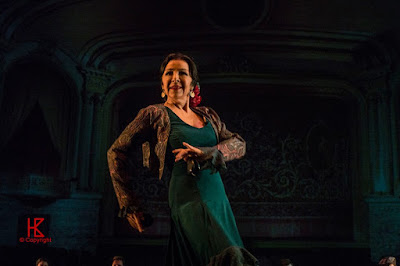Esmeralda Enrique
Spanish Dance Company
' Epocas '
A contemporary expression rooted in tradition
Running until Sunday April 24th, the Esmeralda Enrique Spanish Dance Company is presenting a spectacular program that pays tribute to the rich and complex history of music and dance that bears “the social relevance of…ground-breaking work that stretches far beyond Spain.” (program note) While flamenco dominates the overall texture of this choreographic tour-de-force, it is apparent, in every sequence, that the rhythms, gestures, powerful emotions, and musical excellence draws from an incredibly diverse global history.
Onstage musicians and singers become integral to the dancing ensemble as the program embraces, from start to finish, a fine sense of interconnectedness - singers moving seamlessly from the upstage area to deliver powerful solos, and then, at times, jousting delicately and energetically with a dancer in close proximity.
Beginning with huge projections that represent the history of Spanish dance, one is drawn into the iconic narrative that each consecutive segment moves through. By displaying life size theatre interiors, a sense of absorption frames the dance with a powerful theatricality that gradually moves into subtle textured projections, moon fed nightscapes, and ancient urban scenes that keep the historical homage intact from beginning to end.
With eight separate sets of choreographic brilliance, and two musical features where the musicians and singers command the stage, the overall evening is a plethora of diverse entertainment held together by the intense and intricate choreography of Esmeralda Enrique and dancer/choreography Rafael del Pino.
Rafael del Pino's (aka Keko) solo (Mi Bailey Alegrias) in the second act, pays tribute to 1930’s artist Vicente Escudero, considered “one of the most natural dancers to ever grace the art of flamenco.” Rafael del Pino choreographs and dances with an abandon and unrelenting bravado that has the audience in raptures throughout. His soaring manner, engaging the audience with full facial flirtation, enhances bodily movement that creates a breakneck pacing that is breathtaking. When he shares a duet with Esmeralda Enrique in La Cana, his elegant and unshakeable masculinity reveals, with the magnificent aid of Enrique, a stunning display of how dance partners from the history of Spanish dance were able to bring “another dimension to the art where femininity and masculinity were distinctive and complimentary.” (program)
A beautiful and sensual inter-generational quality is deepened by the presence of two brilliant dancers who bring equal parts passion and camaraderie to this evocative piece.
A beautiful and sensual inter-generational quality is deepened by the presence of two brilliant dancers who bring equal parts passion and camaraderie to this evocative piece.
Grazalema (Zapateado), gracing the second to last portion of the program, features a three dancer ensemble that simultaneously follows and diverges through a complex arrangement of solos and group choreography. The startlingly beautiful black and white costumes, replete with whip like props for each dancer to hold and skilfully maneuver, heightens the tension with tense sexual overtones of the formidable kind.
The mixture of masculine and feminine, created through a fine commingling of costuming and choreography, shows the power of subtle gender blurring. Pamela Briz, Virginia Castro, and Paloma Cortes take on this theatrical dance piece with a kind of precise abandon in solo turns and tight ensemble work that instils both awe and a kind of mild, smouldering fearful quality.
The mixture of masculine and feminine, created through a fine commingling of costuming and choreography, shows the power of subtle gender blurring. Pamela Briz, Virginia Castro, and Paloma Cortes take on this theatrical dance piece with a kind of precise abandon in solo turns and tight ensemble work that instils both awe and a kind of mild, smouldering fearful quality.
Singers Tamar Ilana and Manuel Soto add immense vocal layers to the overall evening, with a range of exquisite accompaniment - from an opening accordion solo to powerful guitar features (musicians - Benjamin Barrile, Rosendo “Chendy” Leon, Jerry Caringi, Caroline Plante).
Perhaps the most intriguing piece, Un Rayo de Sol (Pasodoble/Tangos), features the five ensemble dancers. Enrique, Briz, Castro, Cortes, and Noelia La Morocha, in stunning red gowns, reveal the subtle complex play of masculine and feminine as a historical resistance to imbedded stereotypes -
The distinctly Spanish pasodobe, with its festive nature,
meets the playful and sensual tangos. Amidst conflicting
perceptions of Spanish national identity dancers such as
Carmen Amaya, Pastora Imperio, and Manuela Vargas rose
above social and political tensions perpetuating flamenco
stereotypes in an ideological resistance towards deeply held
ideas of femininity. (program)
Epocas is a sensational evening of flawless historical drama-cum-choreography that brings the timeless strains of an iconic dance form into the impeccably intense world of contemporary flamenco music and choreography - as imagined and made material through the brilliance of the Esmeralda Enrique Spanish Dance Company.
APRIL 22ND - 24TH
FLECK DANCE THEATRE HARBOURFRONT CENTRE
207 QUEENS QUAY W










No comments:
Post a Comment